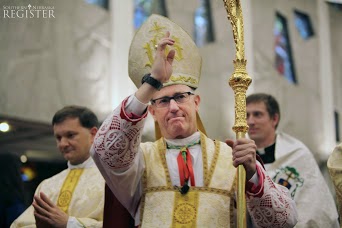Liturgists are often accused of focusing on the pointless minutiae of Christian worship; to the accusers, this articles is a gift! I want to discuss the rarely discussed issue of wearing a watch while ministering liturgically.

The photograph to the right shows Bishop James Conley of the Catholic Diocese of Lincoln, Nebraska. Everything about him in this picture is dignified and elegant in the context of Mass. All except his wristwatch. At first, it looks like a chunky Casio G-Shock on a rubber strap, but it might be something a bit more sophisticated on a ‘gun metal’ bracelet. It is rather obvious, and that is partly because he has chosen to wear it on his right wrist. Priests always bless with their right hand and perform most liturgical gestures with the right, so a watch on the right is always going to have more presence. The picture of Bishop Conley would probably not have jumped out at me if he had worn his watch on the left.
The wristwatch became popular in the early twentie
Most wristwatches have a crown at 3 o’clock. They are traditionally worn on the left wrist so that one could easily wind and adjust them with the right hand (a watch worn on the right is still awkward to work with the left hand, even for a left-handed person, as the hand will cover the face). With the advent of quartz and digital watches, this became less of an issue, and many now wear their watch on their right wrist as a matter of personal choice. However as was noted above, a priest wearing a watch on the right wrist will be constantly flashing it at every liturgical gesture.
Pius IX (1792–1878) was perhaps the first pope to wear a watch and was gifted with a Patek Philippe pocket watch. Pope John Paul II was known to wear a silver-gold Rolex Datejust, which is fairly mid-range as far as Rolexes go (and the same model as worn by the Dalai Lama). Pope Benedict XVI was given a rather fine Junghans Tempus Automatic. Pope Francis wears a little black plastic Swatch. They all wear or wore their watches on their left wrist, and all are fairly subtle, even John Paul II’s Rolex was fairly discreet. The lesson perhaps is that, if a priest wears a wristwatch, it should be a subtle model worn on the left. Even when worn on the left, certain two-handed liturgical gestures — greeting with arms outstretched, raising the Gospel, the orans position, and the elevation of the Eucharistic gifts — can make the watch visible.
Popes and their watches
Some older patterns of cassock come with a small pocket for a pocket watch. The Wippell version has this pocket high on the left breast, while others have it slightly above the waistline, on the left also, so that it is covered by the cincture. One point is that it is virtually impossible to check a pocket watch whilst vested in a surplice or alb, and perhaps there is a meaning deeper than Houdini-like moves in white linen here.
The time of prayer and praise should be timeless. In liturgy, there is a foretaste of the heavenly banquet, and therefore of eternity. I remember one dapper gent at a formal dinner (which are two-a-penny in Oxford) telling me that he thought it incorrect to wear a watch with a dinner jacket, thinking it symbolizes a rather rude indication that one might have other plans. Surely this argument is even more appropriate for divine worship.
In my last parish, the vicar and I would often check our watches at the end of the main Sunday Mass to see how long the service had taken. There is a lot to pack into a big Parish Mass, and it is important to be respectful of the time of congregants. The parish at which I preached last Sunday has a little pocket-watch-shaped indentation on the top edge of the pulpit, sadly sans watch, and, likewise, the good timing of a sermon is important. In the past, a church clock might be the only timekeeper in the parish, so we have a long interest in telling the time (out loud). There is a discipline here of the punctuality needed to honour others and God that leads us to worship, and the timelessness within worship.

To the right is a picture of my Orient Bambino Automatic. It is really cute and quite reasonably priced. Its classic look makes it suitable for wear with the cassock. Its case is a little on the large size, but it remains subtle. I retain the watch for choir offices but have taken to removing it before celebrating Mass for the reasons cited above. I pray
O God, thou art Lord of all time and eternity : in the slenderness of this time that we give unto thy praise, fill thou thy servants with a foretaste of thy eternal promises, through Jesus Christ our Lord.
A very “timely” post Gareth!
Jimmy
He usually removes it before beginning the Liturgy of the Eucharist